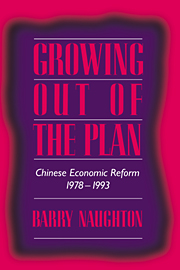Book contents
- Frontmatter
- Contents
- Tables and figures
- Preface
- Introductory
- Phase one The bird in the cage, 1979–1983
- Phase two Reforms take off, 1984–1988
- Phase three To a market economy
- 8 The post-Tiananmen cycle of retrenchment and renewed reform
- 9 Conclusion: Lessons and limitations of the Chinese reform
- Statistical appendix
- Notes
- Bibliography
- Index
9 - Conclusion: Lessons and limitations of the Chinese reform
Published online by Cambridge University Press: 03 May 2010
- Frontmatter
- Contents
- Tables and figures
- Preface
- Introductory
- Phase one The bird in the cage, 1979–1983
- Phase two Reforms take off, 1984–1988
- Phase three To a market economy
- 8 The post-Tiananmen cycle of retrenchment and renewed reform
- 9 Conclusion: Lessons and limitations of the Chinese reform
- Statistical appendix
- Notes
- Bibliography
- Index
Summary
After fifteen years, it is clear that there is substantial ex-post coherence to the Chinese reform process. It should also be clear that this coherence is not the result of a carefully plotted reform strategy. Indeed, during some crucial periods, the coherence of the reform process emerged in spite of, not because of, the policies of Chinese leaders. Coherence was a characteristic of the economic environment in which the transition path unfolded, rather than of the explicit choices of policymakers. Just as planned economies have an internal consistency, so also is there a generally consistent logic to the way such systems dissolve. The interrelatedness of command economies – which is usually seen as an obstacle to reform – may also become an advantage in the transformation process. There are certain critical, or core, features of the command economy, and once those are eliminated or weakened, the system has a tendency to devolve into a different type of system. Provided there is some political will to move the system in the direction of a market economy during this dissolution process, a positive process of transformation may be set in motion even without a clear or comprehensive commitment to a reformed market economy at the outset.
The Chinese transition process has also been robust. Clearly, many of the initiatives advanced by the Chinese government failed, and many of the most successful reform measures were introduced with little forethought or awareness of the consequences.
- Type
- Chapter
- Information
- Growing Out of the PlanChinese Economic Reform, 1978–1993, pp. 309 - 326Publisher: Cambridge University PressPrint publication year: 1995



